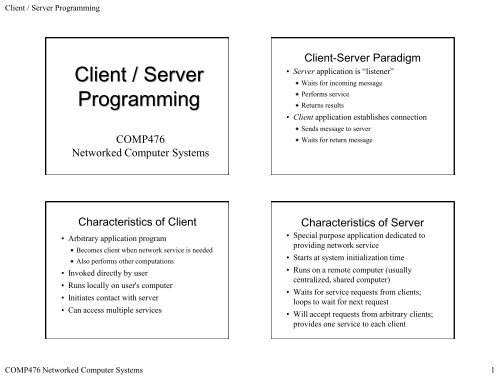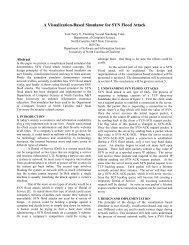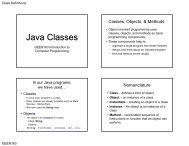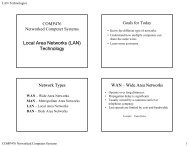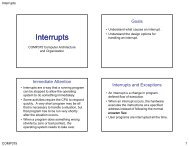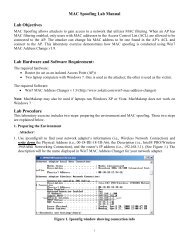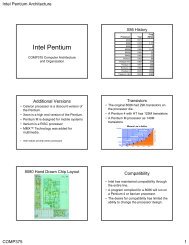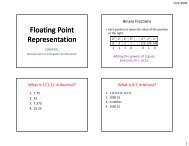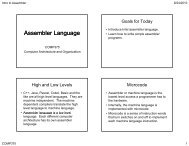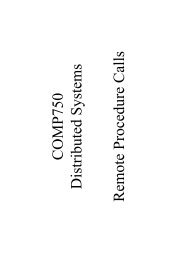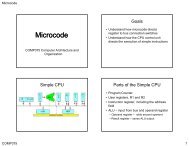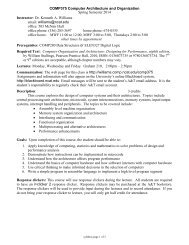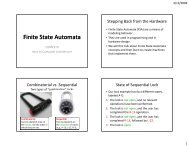Client / Server Programming
Client / Server Programming
Client / Server Programming
Create successful ePaper yourself
Turn your PDF publications into a flip-book with our unique Google optimized e-Paper software.
<strong>Client</strong> / <strong>Server</strong> <strong>Programming</strong>Finding a Service• Write server name in code• Read a file of server addresses• Broadcast request for a server• Ask a human• Name server<strong>Client</strong>-<strong>Server</strong> Interactions• <strong>Client</strong>s can access multiple services• <strong>Client</strong>s may access different servers for oneservice• <strong>Server</strong>s may become clients of other servers<strong>Client</strong>-<strong>Server</strong> Summary• <strong>Client</strong>-server paradigm used in almost everydistributed computation<strong>Client</strong> requests service when needed<strong>Server</strong> waits for client requests• <strong>Client</strong>s and servers use transport protocols tocommunicate• Often, but not always, there is an applicationprotocoljava.net package• Provides the classes for implementingnetworking applications• Sending and receiving data across a network issimilar to writing and reading from a file• The java.net package can be roughly dividedinto high level and low level ApplicationProgrammer Interfaces (API)COMP476 Networked Computer Systems 6
<strong>Client</strong> / <strong>Server</strong> <strong>Programming</strong>java.net Low Level API• The Low Level API deals with thefollowing abstractions:– Addresses, which are networking identifiers,like IP addresses.– Sockets, which are basic bidirectional datacommunication mechanisms.– Interfaces, which describe network interfaces.java.net High Level API• The High Level API deals with thefollowing abstractions:– URIs, which represent Universal ResourceIdentifiers.– URLs, which represent Universal ResourceLocators.– Connections, which represents connections tothe resource pointed to by URLs.Java Socket Classes• Sockets are means to establish a communicationlink between machines over the network.• Socket is a TCP client API, and will typically beused to connect to a remote host.• <strong>Server</strong>Socket is a TCP server API, and willtypically accept connections from client sockets.• DatagramSocket is a UDP endpoint API and isused to send and receive datagram packets.Class java.net.Socket• This class implements TCP client sockets(also called just "sockets"). A socket is anendpoint for communication between twomachines.• Sockets create streams that can be usedexactly like file streams.• Reading and writing to a socket is identicalto reading and writing to a file.COMP476 Networked Computer Systems 7
<strong>Client</strong> / <strong>Server</strong> <strong>Programming</strong>Socket Constructorpublic Socket(String host, intport)throwsUnknownHostException,IOException• Creates a stream socket and connects it tothe specified port number on the namedhost.• Other constructors are available.Methodspublic InputStream getInputStream(throws IOException• Returns an input stream for this socket.public OutputStream getOutputStream()throws IOException• Returns an output stream for this socket.java.net.<strong>Server</strong>Socket• Creates a TCP socket for use by a serverprogram.• A server socket waits for requests to comein over the network.<strong>Server</strong>Socket Constructorpublic <strong>Server</strong>Socket(int port)throws IOException• Creates a server socket on a specified port.• A port of 0 creates a socket on any free port.COMP476 Networked Computer Systems 8
<strong>Client</strong> / <strong>Server</strong> <strong>Programming</strong><strong>Server</strong>Socket Methodspublic Socket accept()throws IOException• Listens for a connection to be made to thissocket and accepts it.• The method blocks until a connection ismade.• Returns a new Socket for communicatingwith the client.Accepting Connections• When a client connects to a <strong>Server</strong>Socket, anew Socket is created on the server• This new Socket is used to communicatewith the client• Typically a new thread on the server wouldcommunicate with the client• The original <strong>Server</strong>Socket can do anotheraccept to wait for another clientUDP Sockets• DatagramSocket is a class to create a Javasocket that uses UDP.• DatagramSocket objects send and receiveobjects of the DatagramPacket class.• A DatagramPacket object contains thedata transmitted along with the address ofthe sender or destination.Java Security• Java applets running in a browser can onlyconnect to the server that hosts the applet.• Java applications generally have norestrictions.• Experience shows that network programmingis easiest on a PC with Java.COMP476 Networked Computer Systems 9
<strong>Client</strong> / <strong>Server</strong> <strong>Programming</strong>Sample Java <strong>Client</strong>public class Tclient {final static String IPname = "whatever.ncat.edu";final static int serverPort = 4567;public static void main(String[] args) {java.net.Socketsock = null;java.io.PrintWriter pw = null;java.io.BufferedReaderbr = null;try {sock = new java.net.Socket(IPname,serverPort);pw = new java.io.PrintWriter(sock.getOutputStream(),true);br = new java.io.BufferedReader(newjava.io.InputStreamReader(sock.getInputStream()));pw.println("Message from the client");String answer = br.readLine();System.out.println("Response from the server >" + answer);pw.close();br.close();sock.close();} catch (Exception e) {Sample Java <strong>Server</strong>public class Tserver {final static int serverPort = 4567;public static void main(String[] args) {java.net.<strong>Server</strong>Socket sock = null;java.net.Socket clientSocket = null;java.io.PrintWriter pw = null;java.io.BufferedReader br = null;try {sock = new java.net.<strong>Server</strong>Socket(serverPort);clientSocket = sock.accept();pw = new java.io.PrintWriter(clientSocket.getOutputStream());br = new java.io.BufferedReader(newjava.io.InputStreamReader( clientSocket.getInputStream()));String msg = br.readLine();System.out.println("Message from the client >" + msg);pw.println("Got it!");pw.flush();pw.close();br.close();clientSocket.close();sock.close();} catch (Throwable e) {COMP476 Networked Computer Systems 10
<strong>Client</strong> / <strong>Server</strong> <strong>Programming</strong>Read a URL with High Level APItry {/* Create a URL and get an InputStream for it. */java.net.URL webFile = newjava.net.URL("http://www.acme.com/myPage.html");java.io.InputStream inFile = webFile.openStream();/* Wrap the InputStream in a BufferedReader */java.io.InputStreamReader inRdr = new java.io.InputStreamReader(inFile);java.io.BufferedReader bufRead = new java.io.BufferedReader(inRdr);/* Read and print all lines of the file. */String html = bufRead.readLine();while (html != null) {System.out.println(html);html = bufRead.readLine();}bufRead.close();} catch (Exception e) { // catch any error and print detailsSystem.out.println(e.getMessage());}COMP476 Networked Computer Systems 11


